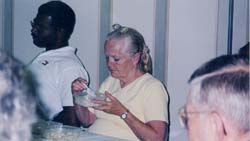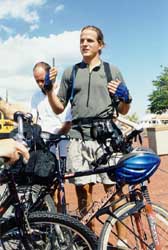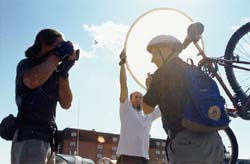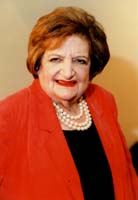| Marylanders Know Their Crab
courtesy Maryland Sea Grant College
Crab tasters included Brenda DeLalla, of Edgewater.
"Yuck. That looks artificial," a voice called out. Heads nodded. Mouths frowned. Ten bodies moved in unison, looking, smelling, touching, tasting crab.
Marylanders sure know their crab.
That's what Maryland Sea Grant College and Seafood Marketi ng found when they organized a series of focus groups, each of 10 consumers chosen as frequent crabmeat buyers and eaters. ng found when they organized a series of focus groups, each of 10 consumers chosen as frequent crabmeat buyers and eaters.
Their effort was part of a three-state initiative with Virginia and North Carolina to promote the declining domestic crab industry.
"We had an ordered approach to the focus group. We decided what questions to ask, how to sequence the questions and how far to pursue the responses," said Tom Rippen of Maryland Sea Grant College.
Questions included: How many times a week do you eat crab in a restaurant? At what meals do you eat crab? Do you prefer fresh or pasteurized crab? Would you purchase crabmeat in a metal can? Do you like lump or special?
The hands-on work came at the end of a two-hour session when panelists compared crabmeats by sight, smell and taste.
To see how Maryland crab stacked up, Bay Weekly joined two focus groups.
I went for the mustardy yellow crab, wanting immediately to take a little bite. But not everyone shared my opinion.
"Yuck. The bleached white looks much cleaner. The mustardy crab is so dirty," said a consumer to my left.
A cleaner meat? A bleached white crab meant chemicals, processing, fake, not good to many other consumers.
"I've been eating crab all my life, and I can tell the difference between brands," said another consumer, claiming the mustardy yellow to be the best.
So many opinions left me spinning, but Rippen said that "out of the chaos came some recurring themes."
One surprise: Maryland consumers' lack of brand loyalty. "We were thinking with heavy crab meat consumers, they would return to the same stores and purchase the same brands," said Rippen. "That's not true."
But Maryland crab eaters want Maryland crabmeat - whatever that means. Maryland packers purchase live crabs from Virginia, New Jersey and North Carolina. When that crab is cooked, processed and packaged in Maryland, it becomes a Maryland product, regardless of what waters the crab swam in.
Freshness got top ranking. Many consumers gave lower ratings to pasteurized products. Rippen claims this is "not because of sensory differences but because of the containers." If a consumer can't see the product, they are not as comfortable buying it. Qualities - and quality - vary widely from packer to packer, but each packer's pasteurized meat is as good as its fresh, Maryland Seafood Marketing's William Sieling insisted.
At the end of the evening, consumers learned the origin of each sample. The favorite, that mustardy yellow crab, was fresh meat packaged by Meredith on the Eastern Shore. The second best was a brownish pasteurized meat from McThompkins, another Eastern Shore packager.
The two that everyone disliked, the bleached white and a grayish meat, were imported from Mexico and Indonesia. Marylanders do know their crabmeat.
Annapolis: Trail's End for Saddle-sore Ed Morris
photo by Mark Burns
Ed Morris, photgrapher and bicyclist, after the ride.
"I really didn't think I should call him Earl, since he's basically a president," reflects Ed Morris, a 21-year-old Severna Park native and student at Brooks Institute of Photography in Santa Barbara, California. "But I didn't want to call him Mr. Old Person, either." a president," reflects Ed Morris, a 21-year-old Severna Park native and student at Brooks Institute of Photography in Santa Barbara, California. "But I didn't want to call him Mr. Old Person, either."
Fresh off the pedals from a two-month cycling trip begun July 15 in Seattle, Morris explains his dilemma while enjoying a pause with family and friends at City Dock Sept. 15. The man of whom he speaks is Earl Old Person, tribal chairman of an Indian reservation in Montana.
Old Person is one of some 90 civic leaders Morris photographed along his bicycling trek across the United States - a fitting journey for the son of Newth Morris, the man credited with starting the B&A Trail. "We picked the route and stopped at every town that we passed through," says Morris, who did the trip with friend and assistant Tim Hovey, 32. If a mayor or other interesting community leader happened to be on hand, Morris would snap a photo; if not, the pair moved on.
The chosen route would take them to 13 states and the District, with stops ranging from Seattle's glittering modern metropolis to a small town frozen in time in the Old West, complete with streetfront boardwalks. Along the way they "picked up the 'ah, geez'" lingo in Minnesota and met with plenty of hospitable enthusiasm; Minot, North Dakota, threw a town party in the cyclists' honor at a local park.
All roads eventually led to Annapolis, where Morris found his final subject in Mayor Dean Johnson. The obliging mayor joined the pair for the final leg, cycling through the Naval Academy before posing with a bike slung over his shoulder at City Dock.
Not all civil servants were so easily photogenic. Some, like President Bill Clinton and Chicago's Mayor Richard Daley, simply didn't have the time. Others were the antithesis of camera friendly. "For a while there, some of [the photography] was probably kind of stale," notes Morris. "But it was a good learning experience for me because it forced me to interact and to get better at getting some life out of people who were frozen. It was a real challenge just getting an honest expression out of them."
His next challenge lies in the darkroom, with about 250 rolls of film waiting to be developed. From those, he must choose his favorite 20 prints, to be pooled for a multimedia exhibit.
In the end, Morris' trip is a success, though he and Hovey never spent the night in a jail or hopped a train like they wanted. "You can't really ride up alongside one and throw a hu ride up alongside one and throw a hu
ndred-pound bike up there," says Hovey.
photo by Mark Burns
Morris photographs Annapolis Mayor Dean Johnson while cycling partner Tim Hovey positions a light diffuser.
Morris still has hopes of getting that photo of President Clinton before returning to California. With Clinton or not, there will be a book. After it's published, Morris hopes a photo exhibit will tour its way to Annapolis. He even has plans for another trip, another year or two off, that won't include bicycles - instead motorcycles or a motorhome.
For now, though, Morris is content to ride home to Severna Park by way of the trail his dad blazed, soak in the pool, go out on the river and part from bike seat for a while. He'll party with old friends, officially celebrating his 21st birthday of 10 weeks past. And when it comes time to return west, there will be no biking involved.
Says Morris, "We're flying back."
The Tiny Terror of Presidents Comes Calling
 Helen Thomas, the White House reporter once called "the woman the presidents love to hate" will be welcomed into Calvert County with open arms and high hopes October 7, to lead off the county public library's Authors by the Bay fund-raising lecture series. Helen Thomas, the White House reporter once called "the woman the presidents love to hate" will be welcomed into Calvert County with open arms and high hopes October 7, to lead off the county public library's Authors by the Bay fund-raising lecture series.
Thomas, who's just taken a new job after 57 years as United Press International's White House reporter, says she's looking forward to coming to Chesapeake Country to talk about her adventures in journalism and her 1999 book, Front Row at the White House.
At 80, Thomas is nowhere near slowing down. Instead of retiring when she quit UPI after it was purchased by the Rev. Sun Myung Moon's Unification Church-owned Washington Times, she promptly hired on as a columnist for Hearst News Service, still keeping her front-row seat at 1600 Pennsylvania Avenue.
Born in Winchester, Kentucky and raised in Detroit, she graduated from Wayne State University certain that one day she would become a great newspaper reporter.
"A goal I still aspire to," says Thomas, not one to rest on laurels, in her book. Thomas was the first woman officer of the National Press Club, the first woman president of the White House Correspondents Association and the first woman member - and woman president - of the prestigious Gridiron Club. She has been named one of the 25 most influential women in America.
"We're very pleased to have Helen as the first speaker in our series," said Donnie Radcliffe, another journalist who has seen her fair share of the White House as a Style reporter for The Washington Post and author of several books about the country's first ladies.
Radcliffe, a Calvert countian and member of the Library Board, counts on Thomas to draw a sell-out crowd.
"Helen was very anxious to help us out. She knows how important it is for us to keep our libraries going," said Radcliffe.
The county library system needs money to build its Prince Frederick Community Learning Center. The Calvert County Commissioners budgeted $2 million earlier this year to the project and have unanimously endorsed efforts by the board to secure an additional $1 million bond issue from the Maryland State legislature.
"But," says Radcliffe, "it is important that people realize that we really need to raise funds from private donations and this lecture series."
Foundation president Pete Hively, too, counts on the Authors by the Bay series to supplement tax dollars "to bring our local libraries to a new level of excellence for the county's expanding population."
For $35, ticket holders not only hear Thomas but also enjoy a dinner buffet before the lecture. To be one of them, you'll have to act fast. Tickets are sold only in advance, through Friday, Sept. 29. "We're hoping that sales will be brisk over the next few days," says Hoffman.
Buy tickets by Sept. 29 at all of the library branches - Prince Frederick, Lusby, North Beach and Fairview - to join Thomas at Rod 'n' Reel Restaurant in Chesapeake Beach on Saturday, Oct. 7: 410/535-0291.
Thousands Throng Bluegrass Festival
Clear notes of the mandolin reach my ears on the late summer breeze. The Deale Bluegrass Festival is well underway. The friendly crowd is in high spirits an d with good reason, for the stage is set for a full day of good music, good eats and hometown fun. d with good reason, for the stage is set for a full day of good music, good eats and hometown fun.
As I survey my lunch possibilities, I recognize a familiar voice coming over the speakers as that of Ray Davis, WAMU radio's bluegrass host. I'm anxious to match the face with the voice, so we take a seat as my daughter digs into her barbecue sandwich. Davis announces the next act, hometown boys Good Deale Bluegrass. Tim Finch and Mark Delaney show off some lightning fast pickin' as they team up with mandolin and banjo for a piece called "Alabama Jubilee." Still moving to the rhythm, we decide to check out the rest of the festivities.
The antique car show piques our curiosity so we amble over to see what the fuss is about. Bright sunshine reflects off the flawless paint jobs as the proud owners sit alongside vintage cars ready to answer questions from an admiring public. A leisurely walk through rows of spotless hot rods leads back to the stage area.
The Nashville Bluegrass Band wraps up the show with toe-tapping tunes, like the classic "Sunny Side of the Mountain," bringing people into the aisles for dancing.
Bluegrass, classic cars and a perfect day brought 5,000 people out to Deale.
Way Downstream ...
In Virginia, Sen. Charles Robb has received the endorsement of the Sierra Club and Clean Water Action in his re-election campaign against challenger George Allen, the former governor. A Sierra Club spokesman asserted that "Robb voted for clean air while George Allen went to court to block enforcement of clean air protection" ...
In Idaho, U.S. Rep. Helen Chenoweth, a Republican, is known for her anti-environmental voting. It caught up to her last week when one of her constituents tossed a rotting salmon at her during a hearing on forest health. Responded Chenoweth: I guess salmon must not be endangered anymore" ...
In San Francisco, officials are considering a ban on outdoor releases of balloons because of their threat to hungry birds and animals who choke to death on them. "This is an entertainment luxury we can do without to protect endangered species," said the city Environmental Commission's Randy Hayes ...
Our Creature Feature comes from Africa, where seven elephants had quite a ride recently. They were air-lifted from South Africa onto the grassy plains of Kissama National Park in Angola, where most of the native elephants died during a civil war. All told, the elephants traveled 2,185 miles, first on a truck and then on a cargo plane. One of them died.
The elephants, between three months and 15 years, hopefully will become the breeding stock for a new herd. The trip was noteworthy, but a relocation effort next year will be truly amazing. In Operation Noah's Ark, they intend to bring 300 elephants by boat to Angola from neighboring Botswana.
Copyright 2000
Bay Weekly
|